-
Welcome to BirdForum, the internet's largest birding community with thousands of members from all over the world. The forums are dedicated to wild birds, birding, binoculars and equipment and all that goes with it.
Please register for an account to take part in the discussions in the forum, post your pictures in the gallery and more.
- Your Local Patch
- Europe & Rest of the World Patches
- Europe
- Spain including the Canary & Balearic Isles
You are using an out of date browser. It may not display this or other websites correctly.
You should upgrade or use an alternative browser.
You should upgrade or use an alternative browser.
Birding Cadiz (& nearby) (2 Viewers)
- Thread starter John Cantelo
- Start date
More options
Who Replied?John Cantelo
Well-known member
Good to hear from you Mike but your kind comment begs the question ... when are you coming out to join me for some birding in Spain? You've had a standing invitation for over ten years!It was a pleasure to be connected to your new thread by Jos Stratford a few days ago John - and I can see you've been pretty busy - with some super-useful info for visiting birders - and an absolutely cracking pic of a Lesser Kestrel!
Cheers
Mike
John Cantelo
Well-known member
A grim but necessary report on the state of the Coto Donana (and by implication Cadiz Province) -
John Cantelo
Well-known member
Just arrived back in Alcala for my usual autumnal break. No car until later on so strictly local birding at the moment (although I'm hoping to nab a place on a pelagic jaunt later). An hour on the terrace this AM netted 70+ Griffons, 2 Egyptians, 4 Booted Eagles & 5 HBs but all frustratingly distant made worse by hazy, muggy conditions.
Jon Turner
Well-known member
Will be out in Jimena on 24th so looking forward to any updates on Sudan Sparrows etc!
John Cantelo
Well-known member
Is it still the sparrow still around? I've not been checking as without transport until 15th it would be too frustrating!
John Cantelo
Well-known member
I returned from Spain in late September with the intention of updating this thread. However a combination of factors - an operation to remove a large lump in my right arm (fortunately it proved to be non-malignant fatty tissue) at the end of the month, a subsequent bout of covid (happily mild but tiring) and now a very sore back - have delayed me.

Hope the health issues are soon all behind you.I returned from Spain in late September with the intention of updating this thread. However a combination of factors - an operation to remove a large lump in my right arm (fortunately it proved to be non-malignant fatty tissue) at the end of the month, a subsequent bout of covid (happily mild but tiring) and now a very sore back - have delayed me.
John Cantelo
Well-known member
I've wanted to go on a pelagic out of Cadiz province for years and in 2022 I finally made it with on jaunt out of Cadiz itself. Although I never got the close-up views of storm petrels and shearwaters I'd hoped for, we did well seeing several species new to my Cadiz list including fly-by Storm and Wilson's Petrel (although the latter's identity was confirmed from photos), Grey Phalarope, Roseate Tern, etc (see my earlier account on this thread). However, I was disappointed that the chum failed to live up to its reputation as a tube-nose magnet and we had no close-range views of lingering birds. Well before arriving in Spain I'd contacted all the local bird tour companies asking for details of any autumnal pelagic trips. Unfortunately, they were all booked up (or failed to respond) so I'd rather given up hope of a seabird trip this year. Fortunately, Birding the Strait decided to lay on an extra pelagic on 23rd September and contacted me with details. This time we were sailing out of Chipiona, one of my favourite seaside towns in the area. As this meant a 07.30 start I opted to stay over in the town the night before and booked into the Hostal Andalucia (- highly recommended & excellent value see hostal-andalucia.com/).
This also gave me time to do some birding in the area and potter around the town. Chipiona has several claims to fame - Spain's tallest lighthouse, ancient fish corrals and, of course, Europe's largest Little Swift colony. It was also a victim of a tsunami caused by 1755 Lisbon earthquake. The Lisbon earthquake is largely forgotten today but at the time it had a profound impact not only physically but also politically and philosophically spawning, amongst other things, Voltaire's morality tale, Candide. However, the people of Chipiona have longer memories than most since not only is there a memorial to the event on the promenade but also the place is dotted with signs indicating the best escape route should another tsunami occur. Cautious folk these "Chipionites"!
And so to the pelagic ...
We left Chipiona at dawn full of hope and high expectations but our optimism proved to be misplaced as ours was one of the few trips this autumn that failed to score a storm-petrel of any kind or any of the less common shearwaters or skuas.
The official tally as published on e-Bird was as follows:-
2 Little Swift
8 Ruddy Turnstone
4 Great Skua
5 Arctic Skua
4 Audouin's Gull
28 Yellow-legged Gull
200 Lesser Black-backed Gull
1 Common Tern
10 Sandwich Tern
4 Cory's Shearwater
7 Balearic Shearwater
18 Gannet
1 Little Egret
14 Glossy Ibis
1 Hoopoe
2 House Sparrow
I'm not sure who did the tallying but it seems a pretty accurate record although I had at least 6 Little Swift (all distant) and would put the number of Audouin's Gulls (and possibly skuas) somewhat lower. It's notoriously difficult to estimate the number of birds in these circumstances and my caution stems from noticing a distinctively marked immature gull that drifted in and out of the boat's wake at intervals (20-30 mins) throughout the trip. The big disappointment was that for the second year in a row, the chum failed to draw any birds in (although it worked on a small shark!). On the other hand, close views of "Cory's" Shearwater allowed me to note the distinctive features of Scopoli's Shearwater for the first time and honestly tick the species/subspecies.
I'll be back next year when I hope that the chum does its job and gives me the close-up encounter with storm petrels that I desire.
This also gave me time to do some birding in the area and potter around the town. Chipiona has several claims to fame - Spain's tallest lighthouse, ancient fish corrals and, of course, Europe's largest Little Swift colony. It was also a victim of a tsunami caused by 1755 Lisbon earthquake. The Lisbon earthquake is largely forgotten today but at the time it had a profound impact not only physically but also politically and philosophically spawning, amongst other things, Voltaire's morality tale, Candide. However, the people of Chipiona have longer memories than most since not only is there a memorial to the event on the promenade but also the place is dotted with signs indicating the best escape route should another tsunami occur. Cautious folk these "Chipionites"!
And so to the pelagic ...
We left Chipiona at dawn full of hope and high expectations but our optimism proved to be misplaced as ours was one of the few trips this autumn that failed to score a storm-petrel of any kind or any of the less common shearwaters or skuas.
The official tally as published on e-Bird was as follows:-
2 Little Swift
8 Ruddy Turnstone
4 Great Skua
5 Arctic Skua
4 Audouin's Gull
28 Yellow-legged Gull
200 Lesser Black-backed Gull
1 Common Tern
10 Sandwich Tern
4 Cory's Shearwater
7 Balearic Shearwater
18 Gannet
1 Little Egret
14 Glossy Ibis
1 Hoopoe
2 House Sparrow
I'm not sure who did the tallying but it seems a pretty accurate record although I had at least 6 Little Swift (all distant) and would put the number of Audouin's Gulls (and possibly skuas) somewhat lower. It's notoriously difficult to estimate the number of birds in these circumstances and my caution stems from noticing a distinctively marked immature gull that drifted in and out of the boat's wake at intervals (20-30 mins) throughout the trip. The big disappointment was that for the second year in a row, the chum failed to draw any birds in (although it worked on a small shark!). On the other hand, close views of "Cory's" Shearwater allowed me to note the distinctive features of Scopoli's Shearwater for the first time and honestly tick the species/subspecies.
I'll be back next year when I hope that the chum does its job and gives me the close-up encounter with storm petrels that I desire.
Attachments
-
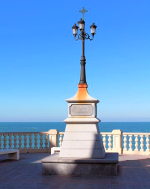 Cruz de Mar.png159.7 KB · Views: 5
Cruz de Mar.png159.7 KB · Views: 5 -
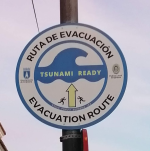 Tsunami.png693.1 KB · Views: 6
Tsunami.png693.1 KB · Views: 6 -
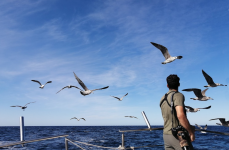 Pelagic III.png1 MB · Views: 5
Pelagic III.png1 MB · Views: 5 -
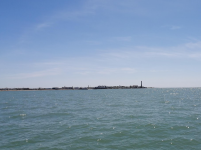 Pelagic 5.png466.2 KB · Views: 6
Pelagic 5.png466.2 KB · Views: 6 -
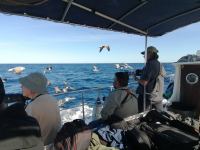 Pelagic 4.png1.3 MB · Views: 7
Pelagic 4.png1.3 MB · Views: 7 -
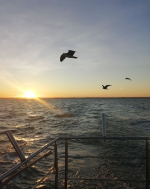 Pelagic 2.png620.7 KB · Views: 7
Pelagic 2.png620.7 KB · Views: 7 -
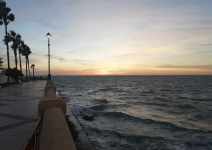 Pelagic 1.png1.1 MB · Views: 7
Pelagic 1.png1.1 MB · Views: 7 -
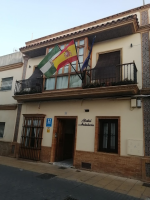 Hostal Andalucia.png839.6 KB · Views: 6
Hostal Andalucia.png839.6 KB · Views: 6 -
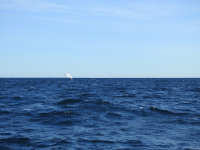 Gannet 1.png927.9 KB · Views: 6
Gannet 1.png927.9 KB · Views: 6 -
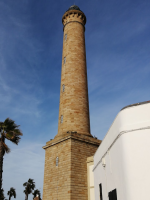 Faro.png679.7 KB · Views: 6
Faro.png679.7 KB · Views: 6 -
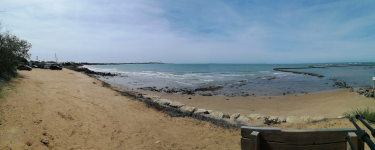 View 1.png1.5 MB · Views: 5
View 1.png1.5 MB · Views: 5 -
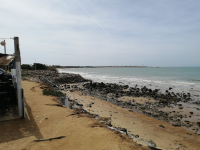 View ii.png1.3 MB · Views: 6
View ii.png1.3 MB · Views: 6 -
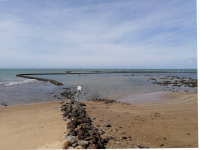 View III.png1.2 MB · Views: 6
View III.png1.2 MB · Views: 6 -
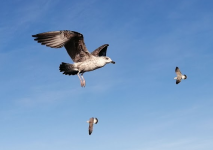 Yellow Legged G.png128.8 KB · Views: 5
Yellow Legged G.png128.8 KB · Views: 5
Last edited:
John Cantelo
Well-known member
I've now seen 23 raptor species - Osprey, Red & Black Kites, Egyptian, Griffon & Black Vultures, Spanish Imperial, Golden, Bonelli's, Booted & Short-toed Eagles, Honey & Common Buzzard, Marsh, Hen & Montagu's Harriers, Goshawk, Sparrowhawk, Common & Lesser Kestrels, Merlin, Hobby and Peregrine - from my terrace in Alcala de los Gazules. Hopes for a 24th species, plus sheer idleness, inclines me when I awake to prefer the 17 steps up to the terrace to an hour's drive to the Straits (where I'll see ten times (or more) as many birds and often rather closer).
So what's left for me to see? The two obvious candidates are Ruppell's Vulture and Black-winged Kite. Spain's second record of the former was found in the parish but despite seeing hundreds of vultures from the terrace annually I've never been able to convince myself that one was a Ruppell's (although I've had a few 'possibles/probables'). I've seen the kite several times only a couple kilometres away but, as yet, have had no luck from my house. Falcons provide three more possibilities - Eleonora's, Lanner and Red-footed. I've yet to see Eleonora's anywhere in the area but have seen Lanner several times near the Straits. I've found a Red-foot on La Janda but a local birder tells me he once had one hawking with local LKs over the town. Spotting either Bearded & White-backed Vultures seems an outlandish suggestion but satellite tracking shows both have passed over the town. I've not seen a convincing 'Long-legged' Buzzard either but since I regard those that turn up in Spain as a race of Common Buzzard I'm not too worried by its absence.
This autumn raptor watching from the terrace was harder work than usual with relatively few birds passing by and many that did were distant and high. I did have my highest September count of Lesser Kestrels from the terrace - 10 birds (although 2-3 was the norm). I was also pleased to get what was only my third Goshawk here and still more pleased (although also tad disappointed) by my very last scan before heading off to Seville and home. I picked up 6-7 vultures over the distant ridge coming straight towards me and, despite being unable to see any colour or get much of a grip on shape, one just felt 'wrong' for Griffon. I had the briefest of glimpses of the upperparts as it turned and they seemed too dark for that species so I was really hoping that it might be a Ruppell's. Finally the birds came overhead and I got a clear view of the underparts. It was a Black Vulture - only my third here but I suspect there'll be more to come as the species probably bred in the Alcorncales for the first time since the 19th century (when they nested near Jimena de la Frontera and possibly near Benalup). It was pleasing to find my ornithological intuition was still in working order even if it detected the 'wrong' vulture!
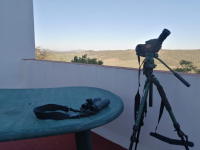
Although my quest to add a 24th BoP to the terrace list failed, I did manage to add one new, and very unexpected, species to the tally. Surprisingly, as most lagunas including Laguna de Medina, were bone dry there were a few puddles of water dotted around the campo. An old ox-bow of the Rio Barbate c750m away below the terrace is usually dry but a heavy downpour before I arrived had filled it with water.
Optimistically 'scoping this little oasis for waders - a scarce commodity so far from any wetland - I was pleased to see several small dots that, after patient watching, proved to be Green Sandpipers. Although I'd previously heard them passing over at night (when my ears still worked!), this was the first time I'd actually seen them. After this small success, I scanned this rapidly diminishing mini-wetland daily hoping one of the Green Sandpipers would turn into their Common or Wood cousins or perhaps a Greenshank. No such luck! However, one morning as I watched I saw an unmistakable flash of bright orange as an even smaller dot flew onto a bare branch in the middle of the puddle. Moments later it flashed bright blue as it returned from whence it came. A Kingfisher! With the Rio Barbate here permanently hidden by a dense cloak of trees, it wasn't a species I'd ever dreamt of seeing here.
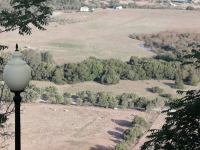
And, of course, even when the birding's lack lustre, there's always the sunset over Medina Sidonia to look forward to!
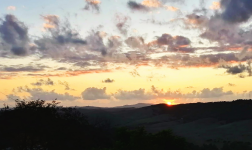
So what's left for me to see? The two obvious candidates are Ruppell's Vulture and Black-winged Kite. Spain's second record of the former was found in the parish but despite seeing hundreds of vultures from the terrace annually I've never been able to convince myself that one was a Ruppell's (although I've had a few 'possibles/probables'). I've seen the kite several times only a couple kilometres away but, as yet, have had no luck from my house. Falcons provide three more possibilities - Eleonora's, Lanner and Red-footed. I've yet to see Eleonora's anywhere in the area but have seen Lanner several times near the Straits. I've found a Red-foot on La Janda but a local birder tells me he once had one hawking with local LKs over the town. Spotting either Bearded & White-backed Vultures seems an outlandish suggestion but satellite tracking shows both have passed over the town. I've not seen a convincing 'Long-legged' Buzzard either but since I regard those that turn up in Spain as a race of Common Buzzard I'm not too worried by its absence.
This autumn raptor watching from the terrace was harder work than usual with relatively few birds passing by and many that did were distant and high. I did have my highest September count of Lesser Kestrels from the terrace - 10 birds (although 2-3 was the norm). I was also pleased to get what was only my third Goshawk here and still more pleased (although also tad disappointed) by my very last scan before heading off to Seville and home. I picked up 6-7 vultures over the distant ridge coming straight towards me and, despite being unable to see any colour or get much of a grip on shape, one just felt 'wrong' for Griffon. I had the briefest of glimpses of the upperparts as it turned and they seemed too dark for that species so I was really hoping that it might be a Ruppell's. Finally the birds came overhead and I got a clear view of the underparts. It was a Black Vulture - only my third here but I suspect there'll be more to come as the species probably bred in the Alcorncales for the first time since the 19th century (when they nested near Jimena de la Frontera and possibly near Benalup). It was pleasing to find my ornithological intuition was still in working order even if it detected the 'wrong' vulture!

Although my quest to add a 24th BoP to the terrace list failed, I did manage to add one new, and very unexpected, species to the tally. Surprisingly, as most lagunas including Laguna de Medina, were bone dry there were a few puddles of water dotted around the campo. An old ox-bow of the Rio Barbate c750m away below the terrace is usually dry but a heavy downpour before I arrived had filled it with water.
Optimistically 'scoping this little oasis for waders - a scarce commodity so far from any wetland - I was pleased to see several small dots that, after patient watching, proved to be Green Sandpipers. Although I'd previously heard them passing over at night (when my ears still worked!), this was the first time I'd actually seen them. After this small success, I scanned this rapidly diminishing mini-wetland daily hoping one of the Green Sandpipers would turn into their Common or Wood cousins or perhaps a Greenshank. No such luck! However, one morning as I watched I saw an unmistakable flash of bright orange as an even smaller dot flew onto a bare branch in the middle of the puddle. Moments later it flashed bright blue as it returned from whence it came. A Kingfisher! With the Rio Barbate here permanently hidden by a dense cloak of trees, it wasn't a species I'd ever dreamt of seeing here.

And, of course, even when the birding's lack lustre, there's always the sunset over Medina Sidonia to look forward to!

John Cantelo
Well-known member
Happily, the plans for a large urbanisation, hotel and golf course on the marshes near Trebujena have finally been terminally scuppered by opposition from the Confederación Hidrográfica del Guadalquivir (CHG - Guadalquivir Hydrographic Confederation) and staunch opposition from the current mayor of Trebujena, Ramón Galán (and previous mayors). The CHG found that the lack of water resources for the macro-urbanization and the golf course made the plan untenable (which environmentalists have been saying for two decades!)
The ambitious plans to convert the area to its former status as c700,000 sq. m. wetland with freshwater pools are now well in hand (at a cost of almost €2 million). The project should be finished in 2024 and is said to provide viewpoints, bird hides and several large pools. These new pools should be viewable from the CA 9027 as it runs along the northern perimeter of the reserve and from the south via a new pedestrian route (although acess details are not yet available and see below for reasons to be pessimistic!). The mayor of Trebujena, Ramón Galán, commented to the media that "Its regeneration will favour the establishment of birdlife and ornithological tourism." A delegate of the Andalusian Government in Cádiz, Mercedes Colombo, added that "This diversity of environments (fresh and brackish), and the existence of different levels of flooding, will allow the lagoons to become one of the main nesting areas for the Marbled Duck, a species classified as endangered at the national level. and that has suffered a dramatic decline in its populations in recent years."
In 2023 I saw diggers and workmen here and, I confess, I assumed the worst – a new drainage scheme perhaps. Fortunately, my pessimism has now turned to optimism and the work on the new reserve should be finished in 2024. Details I’ve been able to find online are rather sparse and, frustratingly, photos in the media reports only had distant shots of dignitaries standing around what seemed to be a plan of the new reserve. After combing through the internet without success, I turned to searching tweets by the local government (Ayuntamiento de Trebujena - @AytoTrebujena). I eventually found a map of the development in a tweet (28/09/2023) which gives a good idea of the scope of the plans.
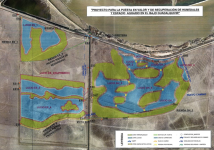
The absence of any scale on the plan doesn't make it easy to appreciate its scope but I managed to superimpose it on an annotated GoogleEarth view of the area which gives a much better idea of the scheme's extent (A = the new reserve, B = the much smaller reserve nearby which has several hides but seems to be permanently locked - hopefully not reflecting the arrangements for this new site). If it comes to fruition as planned then this should be a superb area for finding Marbled Teal, migratory waders and many other sought after species. If and when I have further details regarding facilities, access, etc I'll post them here & on my blog (see the link below) where you can find more photos and details.
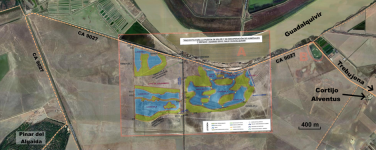
The ambitious plans to convert the area to its former status as c700,000 sq. m. wetland with freshwater pools are now well in hand (at a cost of almost €2 million). The project should be finished in 2024 and is said to provide viewpoints, bird hides and several large pools. These new pools should be viewable from the CA 9027 as it runs along the northern perimeter of the reserve and from the south via a new pedestrian route (although acess details are not yet available and see below for reasons to be pessimistic!). The mayor of Trebujena, Ramón Galán, commented to the media that "Its regeneration will favour the establishment of birdlife and ornithological tourism." A delegate of the Andalusian Government in Cádiz, Mercedes Colombo, added that "This diversity of environments (fresh and brackish), and the existence of different levels of flooding, will allow the lagoons to become one of the main nesting areas for the Marbled Duck, a species classified as endangered at the national level. and that has suffered a dramatic decline in its populations in recent years."
In 2023 I saw diggers and workmen here and, I confess, I assumed the worst – a new drainage scheme perhaps. Fortunately, my pessimism has now turned to optimism and the work on the new reserve should be finished in 2024. Details I’ve been able to find online are rather sparse and, frustratingly, photos in the media reports only had distant shots of dignitaries standing around what seemed to be a plan of the new reserve. After combing through the internet without success, I turned to searching tweets by the local government (Ayuntamiento de Trebujena - @AytoTrebujena). I eventually found a map of the development in a tweet (28/09/2023) which gives a good idea of the scope of the plans.

The absence of any scale on the plan doesn't make it easy to appreciate its scope but I managed to superimpose it on an annotated GoogleEarth view of the area which gives a much better idea of the scheme's extent (A = the new reserve, B = the much smaller reserve nearby which has several hides but seems to be permanently locked - hopefully not reflecting the arrangements for this new site). If it comes to fruition as planned then this should be a superb area for finding Marbled Teal, migratory waders and many other sought after species. If and when I have further details regarding facilities, access, etc I'll post them here & on my blog (see the link below) where you can find more photos and details.

Last edited:
Barred Wobbler
Well-known member
I'm looking forward to seeing that. That Ca9027 road used to be a good spot to view the lagoons between it and the river, but in recent years developments of the pools themselves and extensive vegetation growth have made it not so good. These ponds should bring added interest again.Happily, the plans for a large urbanisation, hotel and golf course on the marshes near Trebujena have finally been terminally scuppered by opposition from the Confederación Hidrográfica del Guadalquivir (CHG - Guadalquivir Hydrographic Confederation) and staunch opposition from the current mayor of Trebujena, Ramón Galán. The CHG found that the lack of water resources for the macro-urbanization and the golf course made the plan untenable (which environmentalists have been saying for two decades!)
The ambitious plans to convert the area to its former status as c700,000 sq. m. wetland with freshwater pools are now well in hand (at a cost of almost €2 million). The project should be finished in 2024 and is said to provide viewpoints, bird hides and several large pools. These new pools should be viewable from the CA 9027 as it runs along the northern perimeter of the reserve and from the south via a new pedestrian route (although acess details are not yet available and see below for reasons to be pessimistic!). The mayor of Trebujena, Ramón Galán, commented to the media that "Its regeneration will favour the establishment of birdlife and ornithological tourism." A delegate of the Andalusian Government in Cádiz, Mercedes Colombo, added that "This diversity of environments (fresh and brackish), and the existence of different levels of flooding, will allow the lagoons to become one of the main nesting areas for the Marbled Duck, a species classified as endangered at the national level. and that has suffered a dramatic decline in its populations in recent years."
In 2023 I saw diggers and workmen here and, I confess, I assumed the worst – a new drainage scheme perhaps. Fortunately, my pessimism has now turned to optimism and the work on the new reserve should be finished in 2024. Details I’ve been able to find online are rather sparse and, frustratingly, photos in the media reports only had distant shots of dignatories standing around what seemed to be a plan of the new reserve. After combing through the internet without success, I turned to searching tweets by the local government (Ayuntamiento de Trebujena - @AytoTrebujena). I eventually found a map of the development in a tweet (28/09/2023) which gives a good idea of the scope of the plans.
View attachment 1551718
The absence of any scale on the plan doesn't make it easy to appreciate its scope but I managed to superimpose it on an annotated GoogleEarth view of the area which gives a much better idea of the scheme's extent (A = the new reserve, B = the much smaller reserve nearby which has several hides but seems to be permanently locked - hopefully not reflecting the arrangements for this new site). If it comes to fruition as planned then this should be a superb area for finding Marbled Teal, migratory waders and many other sought after species. If and when I have further details regarding facilities, access, etc I'll post them here & on my blog (see the link below) where you can find more photos and details.
View attachment 1551719
John Cantelo
Well-known member
Extraordinary news that the bunting bonanza on La Janda now includes 17 Little and 4 Rustic Buntings feeding on stubble. I confess that if I saw them without being pre-warned, I'd assume I was hallucinating or couldn't ID Reed Buntings anymore! I hope they hang around until I get back out there!
occasional
Well-known member
The buntings are to be found where the road from Benalup crosses the old river Celemin. In reality the little buntings are so readily seen that there are presumably several dozen in the area - the rustics are more difficult to find.
John Cantelo
Well-known member
When in the UK it's great, albeit with a tinge of frustration that I'm not there, to be able to watch live video of Lesser Kestrels - my favourite raptor - in Andalucia online. Of course, I'd rather it came from Alcala de los Gazules but Los Barrios is only 40 km down the A381. https://www.youtube.com/watch?v=SmA5vtnOMaE
John Cantelo
Well-known member
Back yesterday from several weeks birding in Cadiz Province (and beyond). Understandably, most visitors go later in spring or in autumn for the raptor passage but restricting yourself to those periods means missing out on some fabulous birding. There are few sights and sounds more rewarding for a birder than flocks of Common Cranes. My highest count was c600 in field around me and buggling as they flew above me. Magical. I'll post more anon.
.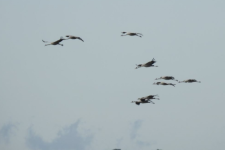
.

John Cantelo
Well-known member
Note that the 'Red-knobbed Coot' I mentioned seeing at Costa Ballena (#50) last year has now been re-identified as a Red-knobbed x Common Coot hybrid which explains its rather poorly developed knobs! Although puzzled at the time by their lack of development, I confess that I assumed it was a juvenile bird (it also had brownish hues in its plumage to encourage such thoughts). Many far more experienced birders than I made the same mistake but I imagine its lack of progress in this regard over several months was a good clue to its parentage.
John Cantelo
Well-known member
As expected, the water levels in the lagunas I visited in February were unseasonally low. Laguna de Medina is traditionally the laguna least likely to suffer from the consequences of a lack of rainfall. As my photos here show there was a wide margin of dried mud and, more worrying, advancing vegetation surrounding a shallow remnant of the lagoon. There were hordes of Yellow-legged and Lesser Black-backed Gulls resting on the water I noted very few ducks (c40 Shoveler), no coots, no grebes and no herons (although the experience of looking was so dispiriting that I didn't look too hard). Since the state of Laguna de Medina is a litmus test for other wetlands I didn't make the effort of visiting most of the famous lagunas in the area but it doesn't take much imagination to realise their probable condition. Rightly, much has been made recently of the dire state of the Coto Donana but it's not the only wetland in danger of extinction in Andalucia - far from it.
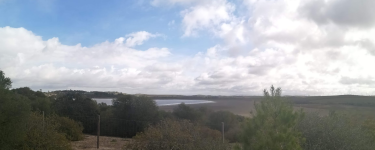
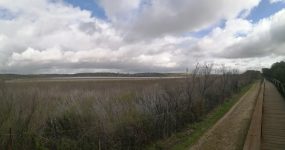


Similar threads
- Replies
- 4
- Views
- 2K
Users who are viewing this thread
Total: 3 (members: 0, guests: 3)




